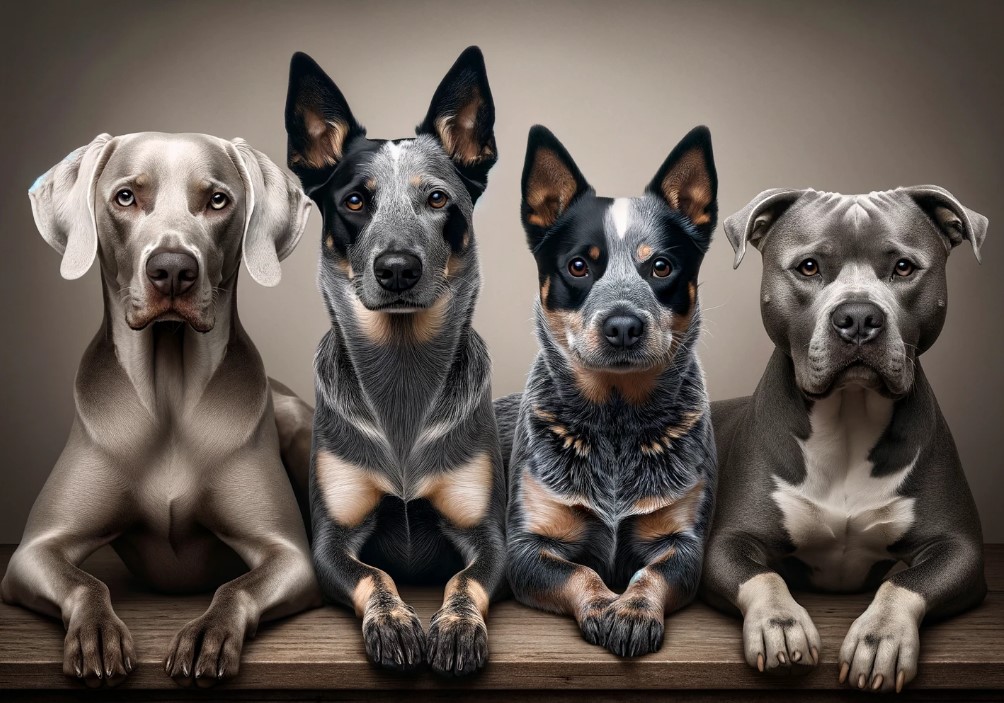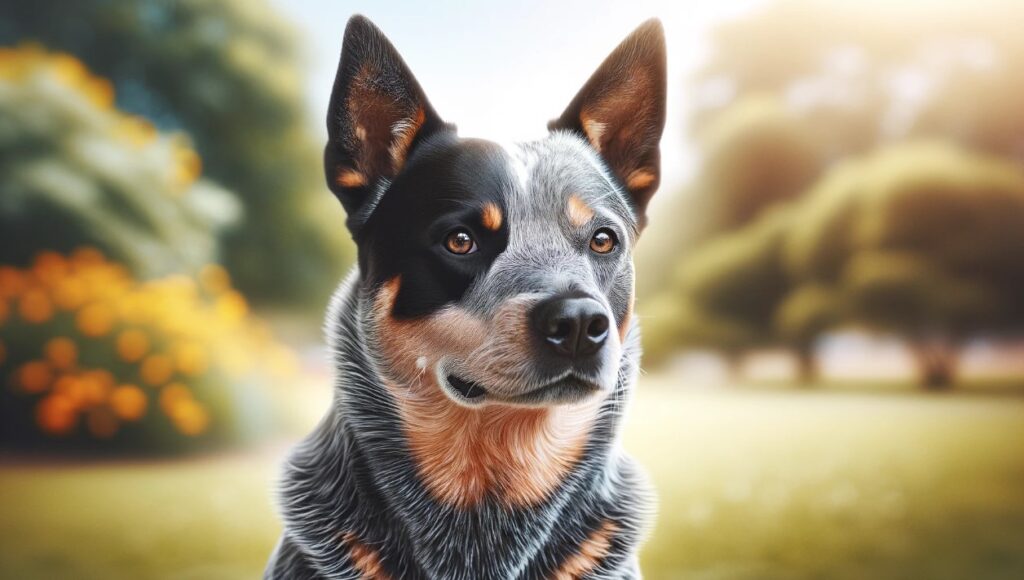Blue Dog Breeds: Uncovering the Mystique of Blue-Coated Canines
Have you ever marveled at the beauty of a dog with a unique blue coat and wondered what makes them so fascinating? Welcome to the world of blue dog breeds, a captivating phenomenon that’s not just skin-deep but intertwined with the complex science of canine genetics. As a holistic veterinarian, I love demystifying the world of blue-coated canines and shedding light on the beauty of these unique dogs, and I’m thrilled to share this journey with you.

When we refer to ‘blue’ dogs, we’re talking about canines with a distinct coat color that ranges from a silvery hue to a deep, charcoal-like tone. This isn’t a result of some unusual coloring or dye, but a fascinating interplay of genetic factors. Understanding the genetics behind blue-coated dogs opens a window into the fascinating world of canine coat color variants and the science that drives them.
There’s a lot of science involved in the creation of a blue-coated dog. Specific genes control the color of a dog’s coat, and these genetics play a significant role in determining whether a dog will be black, brown, white, or in our case, ‘blue’. Some myths circulate around blue-coated dogs, creating confusion and misinformation. By debunking these myths, we can gain a more profound appreciation for these rare, beautiful animals.
In this journey, we’ll dive deep into popular blue dog breeds, each with its unique characteristics and charm. From the sturdy Blue Heeler and the state-prized Blue Lacy, to the mysterious Blue French Bulldog and the misunderstood Blue Nose Pitbull, we’ll explore what makes each breed special. We’ll also address the unique health concerns specific to blue dog breeds and the best ways to provide preventive care for these stunning companions.
So, buckle up, dear dog lovers, as we uncover the mystique of blue dog breeds, diving into the rich tapestry of these blue-coated wonders. And remember, while their coats may be blue, their hearts are gold!
The Science Behind Blue Dog Breeds
Are you intrigued by the enchanting allure of blue-coated dogs? Have you ever wondered how certain breeds boast such a unique hue? As a holistic veterinarian, I’m here to delve into the science behind the mesmerizing color of our blue dog breeds and debunk some popular myths attached to them. So, buckle up as we embark on this fascinating journey into the world of genetics!
The Role of Genetics in Dog Coat Color
When it comes to the color of a dog’s coat, genetics plays a pivotal role. The “blue” coat is actually a diluted black coat, and this color variation is due to a specific gene known as the dilution gene (d). When a dog has two copies of this gene, one from each parent, the color of its coat, nose, and paw pads are diluted or lightened. It’s this gene that gives our beloved canines their distinctive blue-grey hue.
It’s important to note that not all breeds can carry this dilution gene. Only certain breeds, such as the Blue Heeler, Blue Lacy, Blue French Bulldog, and Blue Nose Pitbull, to name a few, have this genetic capability. These breeds are also a testament to the mind-blowing diversity of the canine world and their color variations.
Debunking Myths About Blue-Coated Dogs
Like with all things unique and rare, a series of myths surround blue-coated dogs. Some believe that they are a separate breed altogether or possess special powers. Let me assure you, these are nothing more than fanciful myths. Blue dog breeds are just like any other dogs – their striking coat color doesn’t affect their personality, intelligence, or abilities.
Another common myth is that blue-coated dogs are more prone to health problems. While it is true that certain breeds with the dilution gene might have higher incidences of specific health conditions, it’s not accurate to generalize this across the board. Each breed and even each individual dog has its own set of health risks and concerns. It’s crucial to consult with a knowledgeable vet about your chosen breed’s potential health issues.
Lastly, some people believe that blue-coated dogs are more expensive because they are rare. The price of a puppy, no matter the breed or color, varies greatly and depends on various factors such as the breeder’s reputation, the pedigree of the puppy’s parents, and demand.
At the end of the day, it’s essential to remember that whether a dog has a blue, black, or golden coat, they all need proper care, love, and nurturing to lead a healthy and happy life. So, if you’re considering adopting a blue-coated dog, I assure you, they’ll bring just as much joy and companionship as any other pup. You just get the added bonus of a stunningly beautiful best friend!
Overview of Blue Dog Breeds
When we talk about blue dog breeds, it’s important to note that we’re not referring to dogs that are literally blue. Instead, we’re talking about dogs that have a specific type of coat color that gives off a blueish or grayish hue. This unique pigmentation is due to a specific gene that these dogs possess, which influences the color of their coat.
There are several dog breeds that can have this beautiful blue coat, each with its own unique characteristics and personality traits. Some of the most popular blue dog breeds include the Australian Cattle Dog (also known as the Blue Heeler), the Weimaraner, the Blue Lacy, the Neapolitan Mastiff, and the Kerry Blue Terrier, among others.

Detailed Description of Each Blue Dog Breed
Let’s delve deeper into the unique characteristics of some of these popular blue dog breeds:
• Australian Cattle Dog (Blue Heeler): Known for their intelligence and high energy levels, Blue Heelers are working dogs with a strong desire to herd. They are characterized by their short, dense coat that comes in two colors: red or blue. The blue coat is a mottled or speckled color, giving them a blue appearance.
• Weimaraner: The Weimaraner is a large dog breed known for its sleek, short coat that can range from a mouse-grey to a silver-grey color. They are highly energetic and need plenty of exercise.
• Blue Lacy: The Blue Lacy is the official state dog of Texas and is named after the Lacy brothers who bred them in the 19th century. They have a short, tight coat that comes in three recognized colors: blue, red, and tricolor. The blue is a grey color that can range from light silver to a dark charcoal.
• Neapolitan Mastiff: Though they are usually black, some Neapolitan Mastiffs can also have a blue coat. They are massive and powerful dogs, known for their loose, wrinkled skin and their protective nature.
• Kerry Blue Terrier: As their name suggests, Kerry Blue Terriers have a blue coat that ranges from a deep slate to a light blue-grey. They are known for their soft, wavy fur and their adaptability to various tasks, including herding, guarding, and companionship.
In addition to these, there are other blue dog breeds like the American Staffordshire Terrier, the Great Dane, and the Italian Greyhound, which all can have a blue or gray coat. Despite the color of their coat, each of these breeds has its unique traits and characteristics that make them special.
Remember, owning a dog is a commitment that comes with responsibilities. So, before you fall in love with the unique coat of these blue dog breeds, make sure you’re prepared for the specific care and attention that these breeds require.
Blue Heeler: A Unique Blue Dog Breed
When discussing blue dog breeds, the Blue Heeler, also known as the Australian Cattle Dog, comes to mind. This unique breed is often recognized by its striking bluish coat sprinkled with a variety of patterns.
Understanding the Blue Heeler Breed
Blue Heelers possess an energetic, hardworking, and intelligent nature, making them excellent working dogs particularly in cattle herding. They’re called ‘heelers’ because they herd cattle by nipping at their heels.
Born white, their blue-grey coats develop as they age, thanks to the presence of a gene known as the ‘merle‘ gene. This gene dilutes the black fur on parts of the coat, resulting in a blue or grey appearance. Their attractive coat can range from a light blue hue to a darker steel blue, often mixed with black, brown, or white patches.
This breed is medium-sized, with males typically weighing between 30-50 pounds and standing about 17-20 inches tall at the shoulder. Females are slightly smaller. They have a broad skull and strong, muscular bodies, which account for their agility and endurance.
Care and Maintenance of Blue Heelers
Blue Heelers are known for their high energy levels, so they require plenty of physical and mental stimulation. Regular exercise such as walks, runs, and play sessions in a large yard are a must. Agility training and participation in canine sports like herding trials can also keep them happy and fit.
When it comes to grooming, Blue Heelers have a double coat that sheds heavily, especially during the shedding seasons of spring and fall. Regular brushing at least once or twice a week can help manage shedding and keep their coat healthy.
In terms of diet, these dogs need high-quality dog food rich in protein to match their high energy levels. Portion control is necessary to avoid obesity, a common issue among this breed.
Health-wise, Blue Heelers are generally robust dogs with few breed-specific health problems. However, they can be prone to certain health conditions like progressive retinal atrophy, hip dysplasia, and deafness. Regular vet check-ups and preventative care are crucial for maintaining their overall health.
In conclusion, Blue Heelers, with their distinct blue coats and intelligent, hardworking nature, are a fascinating addition to the world of blue dog breeds. However, their high energy and grooming needs make them best suited to active families or individuals with ample time for training and play.

The Blue Lacy: Texas’s State Dog
When it comes to blue dog breeds, the Blue Lacy holds a special place. This breed is not only unique for its striking blue coat but also for its status as the official dog breed of Texas. If you’re a dog parent or a dog lover, you may find the Blue Lacy intriguing.
Characteristics of the Blue Lacy Breed
The Blue Lacy, also known as the Lacy Dog, is a medium-sized breed known for its intelligence, energy, and versatility. The breed is named after the Lacy brothers who developed it in Texas during the mid-19th century. Primarily used as a working dog, the Blue Lacy is adept at herding, tracking, and hunting.
One of the most distinctive features of this breed is, of course, its blue coat. The coat is short and smooth, and its color can range from a light silvery blue to a darker slate color. However, not all Blue Lacies are blue – they can also be found in red and tricolor varieties. But it’s the blue-coated ones that are most commonly associated with the breed.
Blue Lacies are known for their athleticism and agility. They are medium-sized dogs, typically weighing between 30 to 50 pounds and standing about 18 to 21 inches tall. Their bodies are muscular and well-proportioned, reflecting their working dog heritage.
As for their temperament, Blue Lacies are intelligent, active, and alert. They are known for their strong work drive and are happiest when they have a job to do. They are also loyal and protective, making them excellent family pets.
Training and Care for Blue Lacy Dogs
Due to their high energy levels and intelligence, Blue Lacies require regular physical and mental stimulation. This makes them ideal for active individuals or families who enjoy outdoor activities. They excel in various dog sports such as agility, obedience, and tracking.
Training a Blue Lacy can be a rewarding experience. They are quick learners and eager to please, which makes them highly trainable. However, their high energy and intelligence mean they can also be a bit stubborn. Consistency, patience, and positive reinforcement are key when training this breed.
When it comes to their care, Blue Lacies are relatively low-maintenance. Their short coat requires minimal grooming – a weekly brush will keep it looking its best. They are generally healthy dogs, but like all breeds, they can be prone to certain health conditions. Regular vet check-ups and a balanced diet are essential for their well-being.
In conclusion, the Blue Lacy is a fascinating breed that combines beauty, brains, and brawn. Whether you’re looking for a working dog or a loyal family pet, a Blue Lacy could be the perfect addition to your home. Just remember, this breed thrives on activity and needs an owner who can provide plenty of physical and mental stimulation.
The Mystique of the Blue French Bulldog
The Blue French Bulldog is one of the rarest and most sought-after blue dog breeds. This breed’s unique coloration is due to a rare genetic condition, but it’s not just their coat that’s mesmerizing. These adorable canines are known for their charming personality, compact size, and bat-like ears that give them a distinctive look.
Features of the Blue French Bulldog
Blue French Bulldogs sport a rare coat color that ranges from a deep, dark blue to a lighter, silvery hue. This coat color is actually a diluted version of black, caused by a genetic mutation in the dilution gene. The gene affects the production of melanin, the pigment responsible for the dog’s hair color, resulting in the blue-gray shade.
Beyond their unique color, Blue French Bulldogs are compact and muscular, making them perfect for apartment living. They stand around 11 to 12 inches tall at the shoulder and usually weigh less than 28 pounds. Their large, expressive eyes, coupled with their trademark bat ears, give them an adorable, endearing appearance that’s hard to resist.
These dogs are also known for their sociable and affectionate nature. They’re great companions and are known to get along well with children and other pets. They’re also known for their playful, easygoing nature, making them a hit at dog parks and family gatherings.
Raising a Blue French Bulldog
Raising a Blue French Bulldog can be a delight, but it also comes with its set of responsibilities. To maintain their beautiful coat, regular grooming is necessary. Brushing their coat once or twice a week will help get rid of loose hairs and keep their skin healthy.
Further, like all French Bulldogs, the blue variety is vulnerable to brachycephalic syndrome due to their short noses. This can make them prone to breathing problems, especially in hot weather or after exercise. Owners must ensure they’re not overexerted and provide them with a cool and comfortable environment.
Also, because of their unique genetics, Blue French Bulldogs can be prone to certain skin conditions. Regular vet check-ups and a balanced diet can go a long way in keeping these issues at bay.
When it comes to training, Blue French Bulldogs are eager to please and typically easy to train. Early socialization and obedience training are recommended to ensure they grow into well-behaved adult dogs.
Owning a Blue French Bulldog can be a wonderful experience, given their loving nature and unique aesthetics. As with any pet, raising them requires commitment, love, and a deep understanding of their needs and characteristics. So, if you are considering adding a Blue French Bulldog to your family, be prepared to dedicate time and effort to their care, and in return, you’ll gain a loyal, loving, and absolutely adorable companion.

The Blue Nose Pitbull: A Misunderstood Breed
The Blue Nose Pitbull is one of those blue dog breeds that often bear the brunt of being misunderstood and unfairly stereotyped. These remarkable dogs, with their unique bluish-grey coats and noses, are much more than what they’re often perceived as. Let’s delve into the truth about them and dispel some common misconceptions.
Unveiling the Truth About Blue Nose Pitbulls
One of the most common misconceptions is the belief that Blue Nose Pitbulls constitute a different breed. In reality, they are simply a variant of the American Pitbull Terrier, distinguished by a specific coloration caused by a rare genetic trait. The ‘blue’ in their name comes from their coat’s unique color, which ranges from deep charcoal to a silvery gray, and their noses, which carry a blueish hue rather than the typical black.
Blue Nose Pitbulls are known for their strength and agility. What often goes unnoticed, however, is their innate love for people. They are, in fact, incredibly affectionate and enjoy being around their human family. These dogs are loyal, intelligent, and trainable, and when socialized properly, they can get along well with children and other pets.
It’s important to note that the aggression often associated with these dogs is not a breed trait but rather the product of irresponsible ownership and poor training. Most Blue Nose Pitbulls are the furthest thing from aggressive when raised in a loving, nurturing environment.
Tips for Owning a Blue Nose Pitbull
Own a Blue Nose Pitbull, and you’ll have a faithful companion for life. Here are some tips to ensure you offer them the best possible care:
- Training and Socialization: Blue Nose Pitbulls are intelligent and eager to please. Start training and socializing them from an early age. Use positive reinforcement techniques and expose them to various environments, people, and animals to help them grow into well-rounded dogs.
- Exercise: These are active dogs that require regular exercise. Ensure they get at least an hour of physical activity daily. This can be in the form of walks, playtime, or even agility training.
- Nutrition: Feed your Blue Nose Pitbull a well-balanced diet that meets their nutritional needs. Opt for high-quality dog food that supports their energy levels, muscle health, and overall wellbeing.
- Regular Vet Check-ups: Like all dogs, Blue Nose Pitbulls need regular vet check-ups. Due to the rarity of their blue gene, they can be prone to certain health issues, so keeping up with preventative care is crucial.
In the end, a Blue Nose Pitbull, like any other dog, needs love, care, and understanding. Despite the unfair reputation they often face, they are not inherently dangerous or aggressive. They are intelligent, loving, and loyal dogs that can make outstanding companions when raised with kindness and respect.
Health Concerns Specific to Blue Dog Breeds
As a passionate dog parent, your furry friend’s health is undoubtedly a primary concern. It’s important to know that while blue dog breeds are absolutely stunning, certain health concerns are more prevalent in these unique canines.
Common Health Issues in Blue Dog Breeds
Blue-coated canines are often at a higher risk for certain health conditions due to the genetic traits associated with their blue coat. Here are some common health issues observed in blue dog breeds:
- Color Dilution Alopecia: This is a condition that causes hair loss and skin problems in dogs with diluted coat colors like blue. The hair follicles in these dogs can become abnormal, leading to hair loss starting from a young age.
- Skin infections: Due to the abnormal hair follicles, these dogs are also more prone to bacterial skin infections which can cause intense itching and discomfort.
- Sun sensitivity: Blue-coated dogs are often more sensitive to the sun and can get sunburnt easily.
- Eye conditions: Some blue dog breeds like the Blue Lacy or the Blue Heeler are more prone to certain eye conditions, including progressive retinal atrophy.
It’s crucial to remember that while these health issues are more common in blue dog breeds, they don’t necessarily affect all blue dogs. Regular vet check-ups and a keen eye for abnormalities can help catch any potential issues early.
Preventive Care for Blue Dog Breeds
While certain health risks are higher in blue dog breeds, as a responsible pet parent, there are steps you can take to help your furry friend live a healthy and happy life. Here are some preventive care tips:
- Regular Vet Check-ups: Regular vet visits are a must for timely detection and treatment of any health issues.
- Sun Protection: If your blue-coated pooch is sensitive to sun, use pet-friendly sunscreens and limit their time in direct sunlight.
- Skin Care: Regular grooming can help prevent skin infections. If your dog has color dilution alopecia, special shampoos and skin treatments can also provide relief.
- A Balanced Diet: A balanced diet can boost your dog’s overall health and immune system, helping to prevent many health issues.
Despite these potential health issues, blue dog breeds are undoubtedly beautiful and have plenty to offer. Their striking coat color is only a small part of their charm. Each breed has its own unique set of characteristics, making them fantastic companions. It’s essential to remember that every dog, regardless of breed or color, deserves love, care, and attention. You, as a dog parent, have the power to provide them with a happy and healthy life. So, here’s to celebrating the uniqueness of blue dog breeds and to keeping our furry friends healthy!
Frequently Asked Questions
Q1: What are some examples of blue dog breeds?
A: Some examples of blue dog breeds include the Blue Lacy, Australian Cattle Dog, and the Kerry Blue Terrier.
Q2: What makes a dog’s coat appear blue?
A: The blue coat in dogs is a result of a specific gene that dilutes the black color in their coat, giving it a blueish or grayish appearance.
Q3: Are blue dog breeds rare?
A: Yes, blue dog breeds are considered rare because the gene that causes the blue coat is not common.
Q4: Do blue dog breeds have any specific health issues?
A: Some blue dog breeds may be prone to certain health issues, such as skin problems or hair loss, due to the gene that causes their blue coat. However, this varies from breed to breed.
Q5: How should I care for a blue dog breed’s coat?
A: Regular grooming and a healthy diet can help maintain the coat of a blue dog breed. It’s also important to regularly check for any skin issues, as these breeds can be prone to them.
Dr. Candy, a holistic veterinarian and certified raw dog food nutrition specialist, graduated from Oklahoma State University in 2009 with a DVM and has since specialized in companion animal nutrition, advocating for species-specific diets. With a background in wildlife rehabilitation and oil spill response, she combines holistic health and conventional medicine in her unique approach to treating chronic diseases, allergies, and autoimmune conditions in pets. As the owner of a veterinary practice in Colorado and an author, Dr. Candy is dedicated to educating pet parents and improving the health and happiness of animals.




